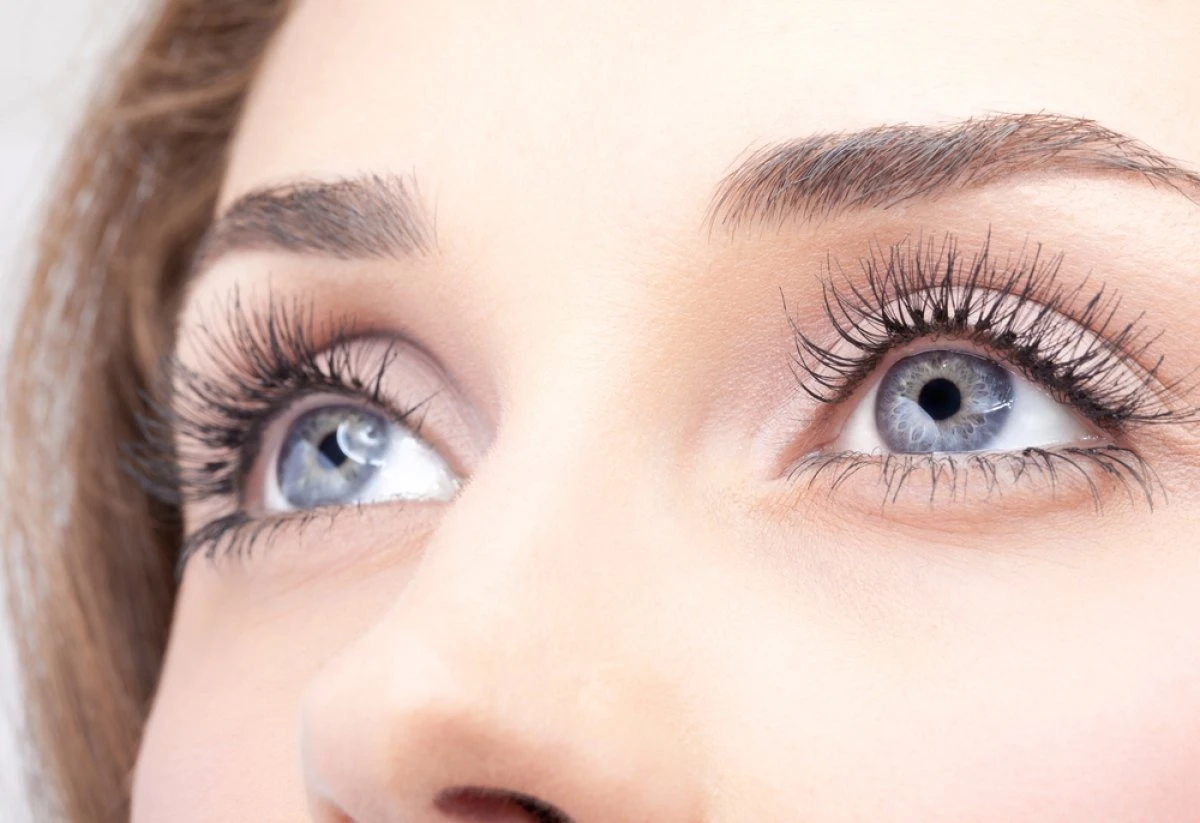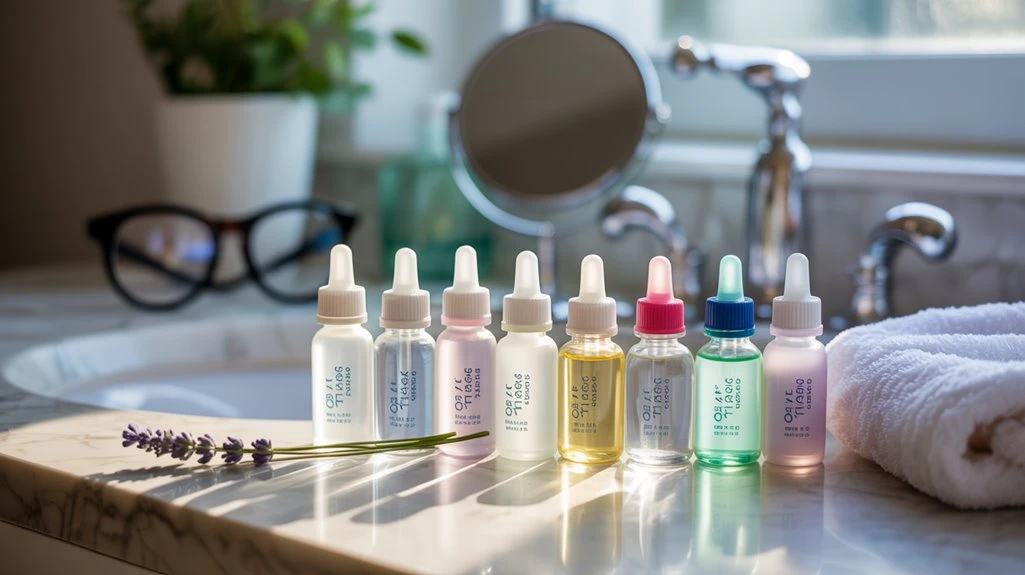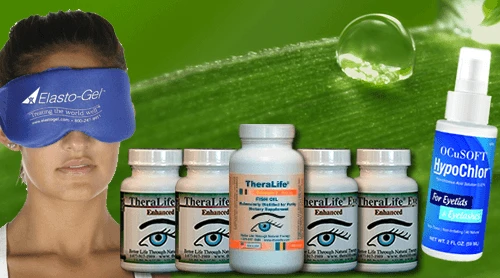For ocular rosacea relief in 2025, consider TheraLife’s unique oral eye treatment products. TheraLife offers an exclusive approach as the only company providing oral solutions for eye care. Their offerings address symptoms like dryness, inflammation, and redness by enhancing tear film integrity and reducing hypersensitivity risk. TheraLife’s anti-inflammatory products effectively manage chronic irritation, catering to individual symptoms with tailored solutions. Always consult your eye care provider before incorporating new treatments into your routine.
TheraLife’s holistic approach extends to various eye conditions beyond ocular rosacea. They provide comprehensive guides and natural remedies for issues such as blepharitis, dry eyes, uveitis, and even managing Sjogren’s syndrome. The company emphasizes the importance of diet and lifestyle in managing eye health, offering insights into anti-inflammatory diets and the best environments for individuals with dry eyes.
Explore TheraLife’s range of products and expert advice to discover how their oral eye treatment solutions can uniquely benefit your specific eye care needs.
Powerful Ocular Rosacea Relief With TheraLife
Chronic dry eye is a significant feature of ocular rosacea.
Treating dry eyes will reduce inflammation and keep ocular rosacea under control
Key Takeaways
- Systane Ultra and Refresh Relieva PF provide effective lubrication and relief from dryness associated with ocular rosacea.
- TheraTears and Blink Tears offer preservative-free options that protect the ocular surface and reduce irritation.
- Xiidra (lifitegrast) and Restasis (cyclosporine) target inflammation and improve tear production for chronic ocular rosacea symptoms.
- Lumify relieves redness temporarily but does not address underlying inflammation or meibomian gland dysfunction in ocular rosacea.
- Always consult an eye care specialist to tailor eye drop selection to individual rosacea symptoms and minimize adverse effects.
Systane Ultra Lubricant Eye Drops
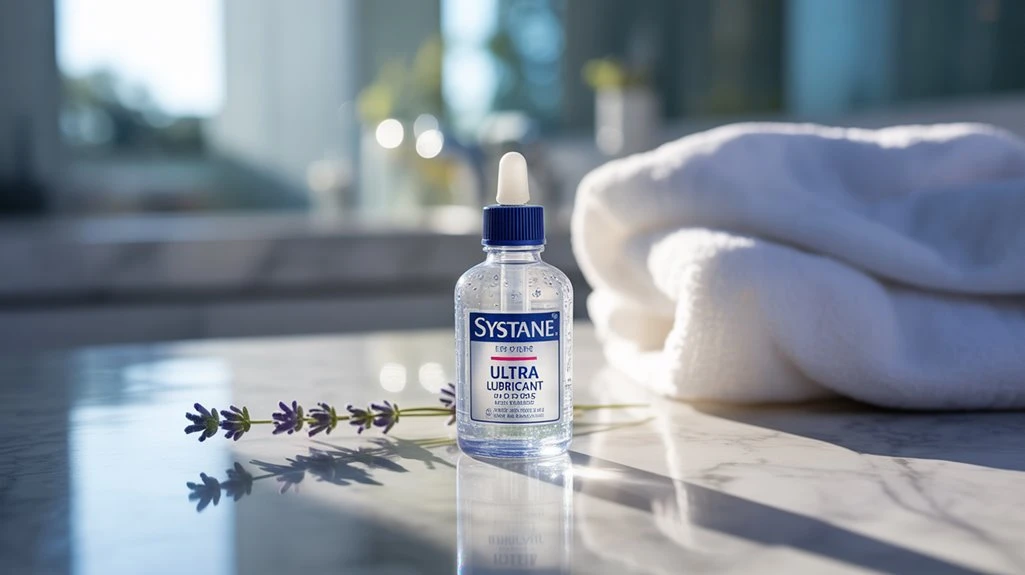
Systane Ultra Lubricant Eye Drops aren’t specifically formulated for treating ocular rosacea. However, you may consider them if you’re seeking symptomatic relief from ocular surface dryness commonly experienced with this condition.
Systane Ultra provides advanced eye lubrication by utilizing polyethylene glycol and propylene glycol, agents known to stabilize the tear film and reduce discomfort related to evaporative dry eye. Clinical studies confirm Systane Ultra’s efficacy in enhancing tear film stability and prolonging ocular surface protection.
While these drops don’t address the underlying inflammation of ocular rosacea, they can mitigate secondary dry eye symptoms such as burning, stinging, and intermittent blurred vision.
The correlation of tear film osmolarity with dry eye severity serves as a diagnostic biomarker, exemplifying the importance of proper diagnosis and tailored treatment.
Always consult an ophthalmologist before initiating or modifying therapy, as tailored treatment targeting both inflammation and tear film instability is critical in ocular rosacea management.
Refresh Relieva PF Preservative-Free
You’ll find Refresh Relieva PF Preservative-Free offers significant advantages for patients with ocular surface sensitivity, given its absence of chemical preservatives.
Its formulation provides sustained hydration to alleviate dryness and discomfort commonly seen in ocular rosacea.
For ideal efficacy, use single-use vials as directed, typically instilling one to two drops per affected eye up to four times daily.
Studies have shown that incorporating Omega 3 fatty acids into a daily regimen can help reduce ocular surface inflammation, which is beneficial for managing symptoms of ocular rosacea.
Preservative-Free Formula Benefits
While many artificial tears contain preservatives to extend shelf life, preservative-free formulations like Refresh Relieva PF are particularly advantageous for individuals with ocular rosacea. Preservatives, especially benzalkonium chloride, can exacerbate ocular surface inflammation and compromise ocular health when used chronically. By opting for preservative-free solutions, you minimize the risk of toxic or hypersensitivity reactions, which is vital for sensitive eyes. Preservative alternatives often fail to provide the same safety profile as completely preservative-free drops, making Refresh Relieva PF a superior choice for long-term use. Proper balance of all three layers of the tear film is crucial to prevent dry eye, and preservative-free drops support this balance. The table below summarizes key benefits:
| Feature | Preservative-Free Drops | Preservative Alternatives |
|---|---|---|
| Ocular Surface Irritation | Minimal | Potential |
| Long-Term Safety | High | Moderate |
| Inflammation Risk | Reduced | Possible |
| Hypersensitivity Reaction | Rare | Occasional |
| Suitability for Rosacea | Excellent | Variable |
Hydration for Sensitive Eyes
Alongside the benefits of preservative-free formulations, effective ocular hydration remains fundamental for managing ocular rosacea symptoms.
When you have sensitive skin around the eyes, maintaining tear film stability becomes paramount. Refresh Relieva PF Preservative-Free is specifically engineered to enhance hydration without introducing irritants, making it a preferred option in evidence-based eye care for individuals with heightened ocular sensitivity.
Its advanced polymeric system mimics natural tears, providing sustained moisture and protecting the delicate ocular surface from environmental triggers. This formulation is especially beneficial when your eyes are prone to dryness, burning, or fluctuating discomfort due to compromised lipid layers.
Moreover, incorporating Omega-3 Fish Oil into your routine may help thicken natural tears and prevent evaporation, thereby complementing the hydration provided by eye drops.
Application and Dosage Tips
To maximize the therapeutic benefits of Refresh Relieva PF Preservative-Free, adhere to a consistent application schedule as recommended by your eye care professional. Typically, the application frequency for ocular rosacea varies based on symptom severity and individual patient response. Most clinicians advise instilling one to two drops in the affected eye(s) up to four times daily, but always follow your provider’s specific dosage recommendations. Confirm hands are clean before administering the drops. Tilt your head back, gently pull down the lower eyelid, and instill the drop without touching the applicator tip to any surface. After application, close your eyes for a minute to enhance absorption. Consistent use, as per prescribed application frequency and dosage recommendations, optimizes hydration, soothes irritation, and supports ocular surface integrity. For those with autoimmune conditions, TheraLife Eye Autoimmune offers a comprehensive approach to managing chronic dry eye symptoms.
Xiidra (Lifitegrast Ophthalmic Solution)
Xiidra (lifitegrast ophthalmic solution) targets inflammation associated with dry eye disease, a common complication seen in ocular rosacea. You’ll find that Xiidra benefits include its mechanism as a lymphocyte function-associated antigen-1 (LFA-1) antagonist, which inhibits T-cell-mediated inflammatory pathways on the ocular surface. Clinical trials confirm that Xiidra reduces both signs and symptoms of dry eye, including ocular discomfort, burning, and foreign body sensation, often reported in ocular rosacea. The use of Xiidra is part of personalized treatment approaches that improve patient outcomes, emphasizing the necessity for a tailored management plan. However, you should be aware of potential Xiidra side effects. The most common adverse reactions include dysgeusia (altered taste sensation), eye irritation, and decreased visual acuity immediately after instillation. Rarely, instillation site reactions or hypersensitivity may occur. Consistent use as directed by your ophthalmologist can maximize therapeutic efficacy while minimizing adverse events.
Lumify Redness Reliever Eye Drops
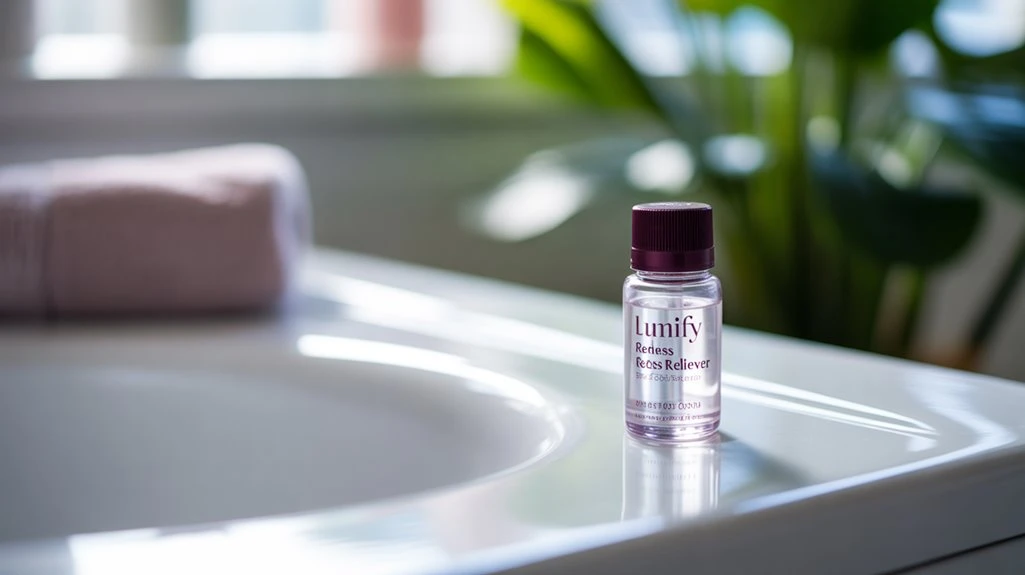
When you use Lumify Redness Reliever Eye Drops, you’re applying brimonidine tartrate to selectively constrict conjunctival blood vessels and reduce ocular redness. Clinical studies support its safety for daily use, but it’s crucial to assess compatibility with the chronic inflammation characteristic of ocular rosacea. Evaluate potential irritation or exacerbation of symptoms before incorporating Lumify into your routine. It’s also important to consider combination therapies that may enhance treatment outcomes for ocular rosacea and dry eyes.
How Lumify Reduces Redness
Although Lumify Redness Reliever Eye Drops are widely marketed for their rapid vasoconstrictive effects, it’s important to understand that their active ingredient, brimonidine tartrate, works by selectively constricting conjunctival blood vessels. This mechanism targets superficial vasculature without impacting deeper retinal or uveal vessels, minimizing the risk of rebound hyperemia. For individuals managing ocular rosacea, Lumify provides prompt redness relief by reducing vascular dilation associated with ocular inflammation. Recent studies suggest a potential genetic link to ocular rosacea, although definitive conclusions about heritability have not been established.
Here’s a breakdown of Lumify’s action:
| Step | Effect on Eye | Clinical Benefit |
|---|---|---|
| Instillation | Absorbed by conjunctiva | Rapid onset |
| Vasoconstriction | Blood vessels narrow | Redness visibly reduced |
| Target specificity | Superficial vessels | Minimizes side effects |
| Duration | 6–8 hours efficacy | Sustained redness relief |
You’ll experience clearer, less inflamed eyes, supporting comfort and confidence.
Safety for Daily Use
While Lumify’s targeted vasoconstriction offers effective redness reduction, routine daily use raises important safety factors for those with ocular rosacea.
You should recognize that Lumify (brimonidine tartrate 0.025%) is FDA-approved for short-term redness relief, not for chronic daily use.
Evidence suggests that excessive reliance may induce tachyphylaxis, rebound hyperemia, or ocular surface changes.
In evaluating daily safety, it’s vital to reflect on your individual risk profile, especially if you have preexisting ocular surface disease.
Current literature lacks robust longitudinal data regarding long term effects of chronic Lumify administration in ocular rosacea populations.
As a result, ophthalmologists recommend using the minimum effective dose and monitoring for adverse reactions such as dryness, irritation, or increased redness.
Meibomian gland dysfunction is a significant factor in ocular surface health and impacts conditions like dry eye syndrome and chalazia.
Always consult your eye care provider to assess the appropriateness of daily use in your specific case.
Compatibility With Rosacea Symptoms
Because ocular rosacea often presents with chronic inflammation, meibomian gland dysfunction, and eyelid margin changes, Lumify Redness Reliever Eye Drops may not address the underlying pathophysiology associated with these symptoms.
You’ll find that while Lumify targets ocular redness by constricting conjunctival blood vessels, it doesn’t manage the chronic inflammation or lipid layer instability characteristic of rosacea.
For ideal symptom management, you should consider how Lumify interacts with your existing rosacea triggers and whether it truly aligns with your therapeutic goals.
- Lumify provides vasoconstriction, reducing visible redness temporarily.
- It doesn’t treat meibomian gland dysfunction or eyelid margin inflammation.
- There’s limited evidence supporting its efficacy in thorough rosacea symptom management.
- Long-term use may mask underlying ocular surface disease without addressing rosacea triggers.
Evaluate Lumify’s compatibility based on your specific symptom profile.
Considering the prevalence of dry eyes in conditions like RA, addressing the root causes of ocular inflammation is essential for comprehensive symptom management.
Powerful Ocular Rosacea Relief With TheraLife
Chronic dry eye is a significant feature of ocular rosacea.
Treating dry eyes will reduce inflammation and keep ocular rosacea under control
Restasis (Cyclosporine Ophthalmic Emulsion)
Restasis (cyclosporine ophthalmic emulsion) is an immunomodulatory agent that inhibits T-cell mediated inflammation on the ocular surface.
If you’re managing ocular rosacea, Restasis effectiveness is supported by clinical trials demonstrating significant improvement in tear production and reduction of ocular surface inflammation.
The cyclosporine benefits extend to restoring tear film homeostasis, which is critical in mitigating the chronic dryness and irritation associated with rosacea-related ocular surface disease.
By directly targeting the inflammatory cascade, Restasis reduces the risk of corneal damage and promotes long-term ocular health.
You should expect a gradual onset of action, with maximal benefits typically observed after several weeks of consistent use.
Restasis also has a favorable safety profile, though transient burning or stinging upon instillation may occur in some patients.
TheraTears Dry Eye Therapy
TheraTears Dry Eye Therapy offers a preservative-free, electrolyte-balanced formulation designed to mimic the natural composition of human tears.
If you’re managing ocular rosacea, you’ll appreciate that TheraTears ingredients include sodium carboxymethylcellulose, sodium chloride, potassium chloride, calcium chloride, and magnesium chloride—critical electrolytes for tear film stability and ocular surface health.
TheraTears benefits include rapid symptomatic relief from dryness, irritation, and inflammation associated with ocular rosacea. Clinical studies demonstrate its efficacy in restoring tear osmolarity and reducing ocular surface damage.
You can use these drops frequently without concern for preservative toxicity, making them suitable for chronic use.
- Preservative-free for minimized ocular surface irritation.
- Electrolyte-balanced to support natural tear function.
- Contains key ions for tear film homeostasis.
- Clinically proven to alleviate dry eye symptoms in ocular rosacea.
Blink Tears Preservative-Free Lubricating Eye Drops
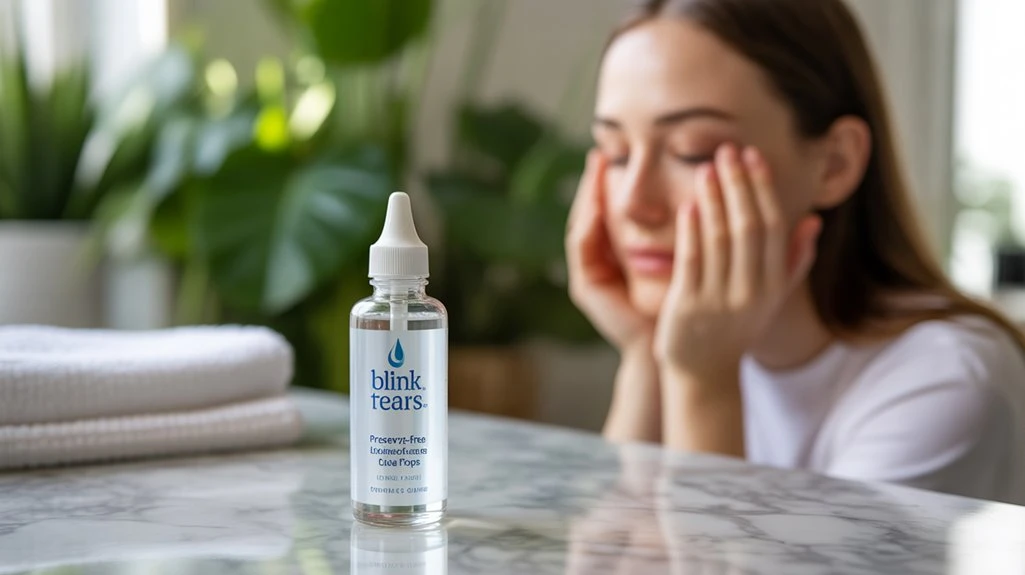
Among the leading options for managing ocular rosacea, Blink Tears Preservative-Free Lubricating Eye Drops stand out for their advanced formulation tailored to restore tear film stability without the risk of preservative-induced irritation.
You’ll appreciate that these drops utilize a hypotonic solution, which helps to counteract tear hyperosmolarity—a key factor in ocular surface inflammation seen in rosacea.
Blink tear benefits include immediate symptom relief, enhanced ocular comfort, and minimized potential for allergic or toxic reactions due to the absence of preservatives.
As one of the most clinically recommended lubricating eye options, Blink Tears supports epithelial healing and maintains mucin layer integrity, both critical for patients with chronic dry eye secondary to ocular rosacea.
Incorporating these drops into your regimen can greatly improve overall ocular surface health.
Powerful Ocular Rosacea Relief With TheraLife
Chronic dry eye is a significant feature of ocular rosacea.
Treating dry eyes will reduce inflammation and keep ocular rosacea under control
Frequently Asked Questions
Can Dietary Changes Help Improve Ocular Rosacea Symptoms?
You can improve ocular rosacea symptoms by implementing dietary changes focused on anti inflammatory foods and appropriate dietary supplements.
Clinical evidence suggests that omega-3 fatty acids, found in fish oil supplements and certain seeds, may reduce ocular surface inflammation. Incorporating foods like leafy greens, fatty fish, and nuts can modulate inflammatory pathways.
You should consult your healthcare provider before starting supplements, ensuring interventions are tailored to your specific ocular rosacea presentation and systemic health.
Are There Any Natural Remedies for Ocular Rosacea?
If you’re exploring natural remedies for ocular rosacea, some patients report mild symptom relief from herbal treatments like chamomile compresses and omega-3 supplementation.
However, clinical evidence supporting these home remedies remains limited and inconsistent. You should exercise caution, as some herbal treatments may cause ocular irritation or allergic reactions.
Always consult your ophthalmologist before trying alternative therapies, as evidence-based interventions remain the cornerstone of ocular rosacea management and safety is paramount.
How Does Ocular Rosacea Differ From Other Eye Inflammations?
When your eyes throw a little tantrum, it’s essential to recognize that ocular rosacea symptoms are distinct from other eye inflammation types.
With ocular rosacea, you’ll notice lid margin telangiectasia, chronic redness, and meibomian gland dysfunction, unlike classic conjunctivitis or blepharitis.
You might experience persistent foreign body sensation, burning, and dry eye.
Unlike allergic or bacterial causes, ocular rosacea often coexists with facial skin changes, requiring targeted, long-term management strategies.
Is Ocular Rosacea Linked to Skin Rosacea Severity?
You’ll find ocular rosacea isn’t always directly proportional to skin rosacea severity, though a skin connection does exist.
Clinical studies indicate that shared rosacea triggers—such as heat, spicy foods, or stress—can exacerbate both cutaneous and ocular symptoms.
However, some patients develop significant ocular involvement even with minimal skin manifestations.
Consequently, you can’t reliably predict ocular rosacea severity based solely on dermatological findings; an individualized, thorough assessment remains essential.
Can Contact Lens Wearers Use Eye Drops for Ocular Rosacea?
Imagine slipping in your contact lenses and instantly feeling soothing relief rather than irritation.
When you’re managing ocular rosacea, you must guarantee eye drops offer contact lens compatibility and sustained effectiveness. Not all formulations are suitable—preservative-free, lubricating drops are typically safest, as they won’t compromise lens integrity or ocular surface health.
Always remove contacts before instillation, wait at least 15 minutes, and consult your ophthalmologist for drops specifically validated for use with contact lenses.
Powerful Ocular Rosacea Relief With TheraLife
Chronic dry eye is a significant feature of ocular rosacea.
Treating dry eyes will reduce inflammation and keep ocular rosacea under control
Conclusion
Choosing the right eye drops for ocular rosacea is essential for enhancing comfort and visual health. Research indicates that up to 58% of individuals with ocular rosacea suffer from moderate to severe dry eye, highlighting the necessity for targeted treatment. While many products focus solely on topical solutions, TheraLife stands out as the only company offering oral treatment options for eye conditions, providing a comprehensive approach to eye care.
TheraLife’s products are designed to address inflammation, tear film instability, and redness, optimizing symptom control for those with ocular surface diseases. Their unique oral treatment approach not only caters to ocular rosacea but also offers solutions for various eye disorders, effectively improving overall eye health. Before starting any new treatment regimen, it’s crucial to consult with an ophthalmologist to ensure compatibility with your specific condition. Explore the benefits of TheraLife’s innovative oral eye care solutions for enhanced management of this often underdiagnosed chronic condition.
REFERENCES
- 1.Two AM, Wu W, Gallo RL, et al. Rosacea: part I. Introduction, categorization, histology, pathogenesis, and risk factors. J Am Acad Dermatol. 2015;72:749–760; quiz 759–760. [DOI] [PubMed] [Google Scholar]
- 2.Culp B, Scheinfeld N. Rosacea: a review. P T. 2009;34:38–45. [PMC free article] [PubMed] [Google Scholar]
- 3.Alvarenga LS, Mannis MJ. Ocular rosacea. Ocul Surf. 2005;3:41–58. [DOI] [PubMed] [Google Scholar]
- 4.Vieira AC, Mannis MJ. Ocular rosacea: common and commonly missed. J Am Acad Dermatol. 2013;69:S36–S41. [DOI] [PubMed] [Google Scholar]
- 5.Rainer BM, Kang S, Chien AL. Rosacea: epidemiology, pathogenesis, and treatment. Dermatoendocrinol. 2017;9:e1361574. [DOI] [PMC free article] [PubMed] [Google Scholar]
- 6.Webster GF. Rosacea. Med Clin North Am. 2009;93:1183–1194. [DOI] [PubMed] [Google Scholar]
- 7.Heisig M, Reich A. Psychosocial aspects of rosacea with a focus on anxiety and depression. Clin Cosmet Investig Dermatol. 2018;11:103–107. [DOI] [PMC free article] [PubMed] [Google Scholar]
- 8.Wilkin J, Dahl M, Detmar M, et al. Standard classification of rosacea: report of the national rosacea society expert committee on the classification and staging of rosacea. J Am Acad Dermatol. 2002;46:584–587. [DOI] [PubMed] [Google Scholar]
- 9.Geng RSQ, Slomovic J, Bourkas AN, et al. Ocular rosacea: the often‐overlooked component of rosacea. JEADV Clin Pract. 2024;3:1349–1363. [Google Scholar]
- 10.Patel NV, Gupta N, Shetty R. Preferred practice patterns and review on rosacea. Indian J Ophthalmol. 2023;71:1382–1390. [DOI] [PMC free article] [PubMed] [Google Scholar] [Retracted]
- 11.Tan J, Blume-Peytavi U, Ortonne JP, et al. An observational cross-sectional survey of rosacea: clinical associations and progression between subtypes. Br J Dermatol. 2013;169:555–562. [DOI] [PubMed] [Google Scholar]
- 12.Longo CM, Adam AP, Wladis EJ. Rosacea and the eye: a recent review. Expert Rev Ophthalmol. 2018;13:57–64. [Google Scholar]
- 13.Schaller M, Almeida LMC, Bewley A, et al. Recommendations for rosacea diagnosis, classification and management: update from the global ROSacea COnsensus 2019 panel. Br J Dermatol. 2020;182:1269–1276. [DOI] [PMC free article] [PubMed] [Google Scholar]
- 14.Ghanem VC, Mehra N, Wong S, et al. The prevalence of ocular signs in acne rosacea: comparing patients from ophthalmology and dermatology clinics. Cornea. 2003;22:230–233. [DOI] [PubMed] [Google Scholar]

